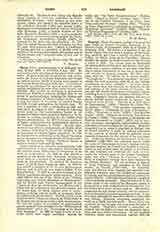

Casey, JOHN, mathematician, b. at Kilkenny, Ireland, May 12, 1820; d. at Dublin, January 3, 1891. He received his early education in the school of his native town. As soon as his age permitted he took service under the Board of National Education and taught in various schools, finally becoming head master of the Central Model School of Kilkenny. In his leisure moments he cultivated his natural taste for mathematics, learning at the same time Latin, French, and German. His success in obtaining a geometrical solution of Poncelet’s problem brought him to the notice of mathematicians, including Dr. Salmon and Professor Townsend of Trinity College, Dublin. Following the advice of the latter, he entered Trinity in 1858, though approaching his fortieth year. He won a sizarship in 1859, a scholarship in 1861 and took his B. A. degree in 1862. During the following eleven years he was mathematical master in the Kingstown School where he gained distinction by his success in training candidates for the Indian Civil Service examinations. In 1873 he became professor of higher mathematics and mathematical physics at the Catholic University in Dublin. Shortly afterwards he was offered a professorship at Trinity which he refused, preferring to devote his energies to the advancement of Catholic higher education. In 1881 he was elected to a fellowship in the Royal University and at the same time was appointed lecturer on mathematics at University College, Stephen’s Green, a position which he held until his death.
Casey carried on an extensive correspondence with mathematicians at home and abroad, and during his life received many distinctions in recognition of his work in mathematics. In 1866 he was elected a member of the Royal Irish Academy, serving for many years as a member of its council, and for four years as vice-president. He received the honorary degree of LL.D. from Trinity in 1869. In 1874 he was elected a member of the London Mathematical Society, and in 1875 he was made a Fellow of the Royal Society. In 1878 he served as secretary of the British Association during its Dublin meeting. From 1862-1868 he was one of the editors of the “Oxford, Cambridge and Dublin Messenger of Mathematics” and for several years Dublin correspondent of the “Jahrbuch tiber die Fortschritte der Mathematik”. Casey was an enthusiastic and devoted teacher and yet found time for much original work in mathematics, confining himself chiefly to geometry which he treated with much ability. He was withal a man of ardent piety, being a member of the Third Order of St. Francis and for many years a daily communicant. He was the author of a number of mathematical papers, many of them published in the “Philosophical Transactions” and in the “Proceedings of the Royal Irish Academy”. In 1881 he began a series of text-books which were highly esteemed. Among his works are: “On Cubic Transformations” Dublin, 1880); “Sequel to Euclid” (Dublin, 1881); “Treatise on the Analytic Geometry of the Point, Line, Circle and Conic Sections” (Dublin, 1885); “Treatise on Plane Trigonometry containing an account of the Hyperbolic Functions” (Dublin, 1888); “Treatise on Spherical Trigonometry” (Dublin, 1889).
H. M. BROCK

